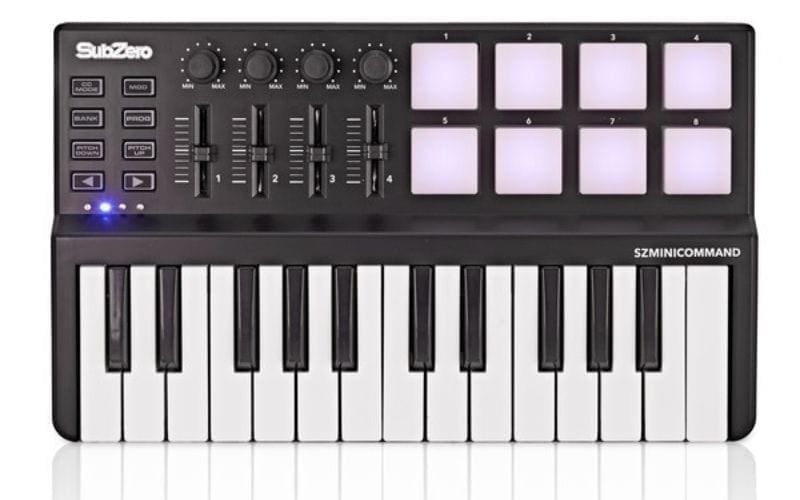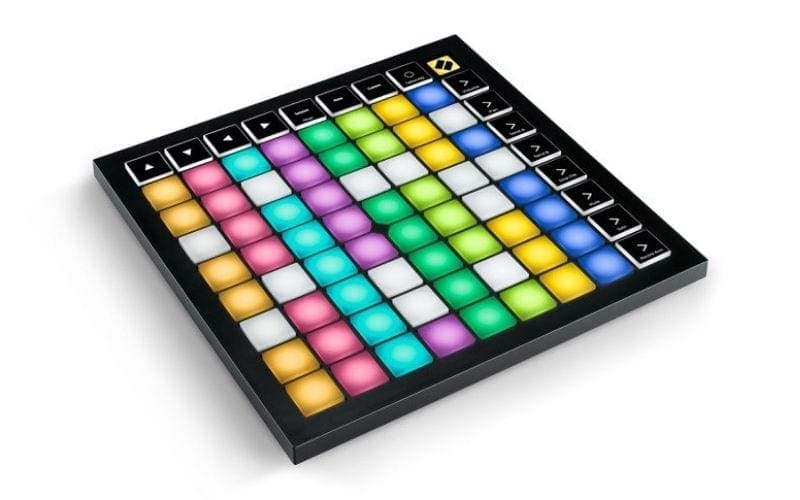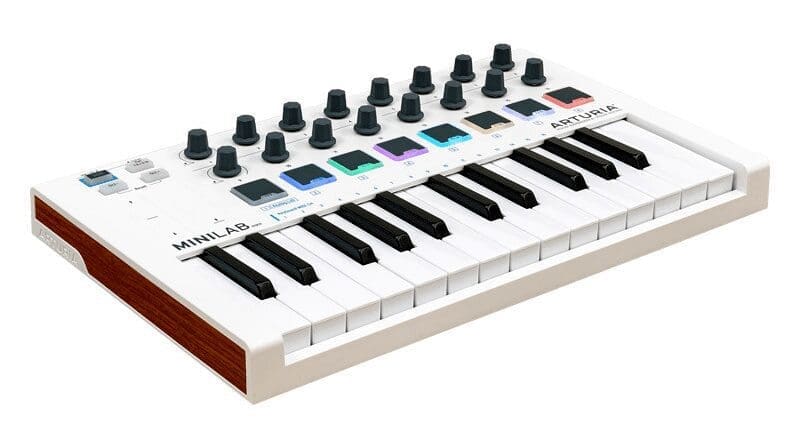A MIDI keyboard is widely used in music production – but what are they, and what exactly is MIDI? What MIDI keyboard for music production is the best on the market at the moment? In this article, I will give you a rundown of the top five USB MIDI keyboard controllers for sale. I will be including features, pricing and more, and give you advice on what to purchase for your DAW/beat maker and home recording studio set-up.
So, sit back, reflex and soak up my insights aimed at saving you bundles of time scouring the internet.

What Is MIDI?
So, what exactly is MIDI? Let’s take a look at the history of MIDI, and how it works.
Music has always developed alongside technology. The first iron-framed piano allowed Beethoven and his contemporaries to experiment with over 7 octaves rather than the 5 afforded to Mozart on the Harpsichord. Rickenbacker’s electrification of the lap steel guitar paved the way for amplification, and Leo Fender’s electric guitars changed the face of music forever.
The dawn of the Digital Age and the rise of DAWs and virtual instrumentals (for example free VST Plugins and DAWs such as Pro Tools X, FL Studio, Cubase, Reaper, Logic Pro X and Ableton Live) also brought with it a new tool in the musician’s arsenal. MIDI (Musical Instrument Digital Interface) was a standardised digital language. It was the brainchild of Roland founder Ikutaro Kakehashi and the likes of Oberheim Electronics, Sequential Circuits, Yamaha, Korg, Kawai and Moog.
How Does A MIDI Keyboard Work?
This digital language allows musicians to use MIDI keyboard controllers to make an array of sounds from one keyboard. Also, musicians can use those devices to talk to other systems and sync together using a common clock and BPM. MIDI can be used to trigger sequencers, and other MIDI instruments and load sounds or voices from other sources.
Nowadays, MIDI is as ubiquitous in music as guitars. You can even use a MIDI keyboard with pads to trigger loops and backing tracks for performances in conjunction with software like MainStage 3 or Ableton Live. Whether you are playing directly into your DAW, or programming complex drum patterns, the world of MIDI keyboards is one that can seem daunting.
How To Setup A MIDI Keyboard
There are essentially three main ways to set up a MIDI keyboard. They are:
- Traditional MIDI Ports
- USB Ports
- Bluetooth Connection
If you take a look at the outputs on your MIDI keyboard, are there MIDI ports? Most traditional keyboards have MIDI in and out, and for controllers, it may just have MIDI out. Not to worry – that’s fine and correct! There are tons of helpful YouTube videos that specifically show how to connect different models, so if you get really stuck, search for your keyboard/controller and you should be all sorted.
Our Top Picks For MIDI Keyboards
So, now that you understand MIDI and its history a little better, let’s take a look at some of the MIDI keyboards available in 2020. Here are the top five that appeal to me:
1. The AKAI Professional MPK Mini MK 2

Price – £70 GBP / $90 USD
In the MIDI game, AKAI is one of the biggest players. They have a range of keyboards to suit every budget and requirement. For me, the MPK mini MK 2 is a triumph.
It’s a mini MIDI keyboard that packs a punch. Lightweight and portable, it doesn’t require any power supply apart from a USB connection. This means it’s great for live performances. It has 8 responsive pads that you can assign to triggers or drum sounds, and an A/B Bank button which means you can have up to 16 options. It also has 8 knobs which you can assign to controls such as volume or LFO controls for Synth sounds.
There is a joystick which gives you interesting pitch bend options, but I have experienced issues with the joystick pinging random MIDI notes rather than carrying out the pitch bend, so be careful in choosing the correct software instrument. You can also add in a sustain pedal input via the jack on the back, which gives you a few more options for using more of the traditional piano sounds.
The MPK has a built-in arpeggiator which works perfectly. A lot of the key buttons are backlit, which lets you know which bank or octave is live, and which pad is currently responding. Plus, the AKAI MPK comes with a free download of Ableton Live 10 Lite, meaning you can get started with music production straight away!
Overall, the AKAI MPK is a great all-rounder cheap MIDI controller keyboard, and perfect for a working recording studio or for live performance.
2. The ROLI Seaboard RISE 25 Expressive MIDI Controller

Price £500 – £800 GBP / $645 – $1,000 USD
Let’s get the obvious out of the way – this thing is weird.
The ROLI Seaboard looks like it’s come straight out of the console of some alien mothership lost in space. It feels a bit like that, too! The soft rubber keys feel strange like there’s a gel that moves around underneath your fingers and responds to the weight of your press (semi-weighted keys). There are subtle sideways movements you can make with your fingers to achieve vibrato, and you can slide between notes and use the panel across the top to manipulate the sound.
Movie buffs might recognise the Seaboard as one of the tools used by Ryan Gosling in LA LA Land, where he performs as part of John Legend’s band and gets a nice solo on the Seaboard, showing off some of the instrument’s capabilities quite effectively in the process.
Seaboard Pros & Cons
The cost might be off-putting, but when it comes to how much you can manipulate and humanise each note, there is nothing like the Seaboard. The functionality literally at your fingertips is astonishing, and the Seaboard forms part of the wider ROLI ecosystem. This can lead you down a path to the ROLI Blocks for another different method of input and the software kits (including iOS Apps) that invite you to a new world of sounds and recording.
With the vibrato and modulation wheel effects on the keys, the Seaboard is particularly effective at some of the synth and stringed instrument sounds. On the ROLI website, there are some incredible guitar-like tones which you can’t really get from any other MIDI keyboard. With the price involved and the added complication of essentially learning a new instrument in order to master it, this is a MIDI controller not for the fainthearted – but hey, since when have musicians been fainthearted?
See the ROLI Seaboard In Action:
3. The Novation LaunchPad

Price £200 GBP / $260 USD
While the Launchpad is not technically a keyboard, you can’t have a conversation about MIDI controllers without at least acknowledging the Launchpad.
The Launchpad was designed by Novation specifically for working with Ableton, so it is amazing in a live performance setting or a recording situation where you are reliant on creating loop-based music. Bands such as HANNIE have delved deep into what is possible with a tool like the Launchpad, and figures like Timberland, are a mainstay of the studio desk. It is great for playing drum sounds, but can be used for so much more! The color-coded display (each of the 64 pads is underpinned by Red, Green and Blue LEDs) matches the colors of your clips in Ableton. It can be used to launch clips and create entire songs as well as to control the mixer, start and stop loops, arm tracks, and control volumes, pans and sends.
Although designed for Ableton Live, it will still work with other DAWs, including Logic Pro X and Pro Tools X. However, there may be a little bit of set-up required. For me, one of the best things about the Launchpad is how it allows you to engage with your tracks in a more creative manner, especially when working with percussion or drums and looping. For some, it might be seen as something to use in parallel with a standard MIDI keyboard rather than instead of.
If the Launchpad is too much of a jump, Novation also makes an excellent product called the Launchkey. This gives you 25 keys with 16 LED pads, which is one of the best MIDI keyboards for beginners.
See The Novation Launchpad In Action:
4. The Arturia MiniLab MKII

Price £80 GBP / $100 USD
The Arturia MiniLab keyboard comes in at a similar price to the AKAI Professional MPK. At first glance, its features look similar, but it also looks great with a white shell and wood panelling effect on the edges. There are actually also a few features under the hood that give the Arturia the edge over the AKAI.
The keys and pads are velocity-sensitive, which makes them a lot more responsive for performance, recording, pitch bend and modulation. This responsiveness comes in handy, especially when using the Grand Piano D VST plugin (sampled from a real Steinway Grand Digital Piano). It sounds absolutely gorgeous. The best thing? It comes with the keyboard as a free download! This cheap MIDI keyboard also affords the Analog Lab Lite software package. This gives you access to hundreds of iconic preset keyboard sounds taken from Arturia’s award-winning V Collection 5. This includes everything from electric pianos to analogue mono synths and string machines to modular monsters.
Arturia MiniLab In Action:
5. The Korg nanoKEY Studio

Price £110 GBP / $140 USD
The Korg nanoKEY Studio is a great tool for step recording. The spaced-out keys are velocity-sensitive and have a Scale Guide function. This highlights the notes in a scale with a backlight. So, even if you are relatively new to making music with keyboards, this can make it easy for you.
The keyboard includes 8 trigger pads which can be used for drum sounds. A nice feature is that you can also use them to play chords in the key that you have selected. Plus, being a Korg product, the middle is graced with a touchpad inherited from the KAOSS PAD and Kasossillator. This allows you to control a synthesiser with one finger; or control a plugin in the same way as the old-style KAOSS PADS work.
The nanoKey is Bluetooth-compatible as well. This means it can be used either with a computer or on an iPad/iPhone with Garageband or KORG Gadget apps.
See the Korg nanoKEY in action:
So, Which MIDI Keyboard Is Best?
As with all things involved in making your own music, the answer to which is best depends on the user. It is important to consider your budget, your experience, and the setting in which you will be using it.
If you are looking for a cost-effective all-rounder, then Arturia is the best model to choose – especially given its additional software. However, if you are looking at drum programming and live performance, then the Novation Launchpad is a great option. Plus, if you’re new to recording and performing with MIDI then the KORG would be great.
Ultimately, the ROLI Seaboard is the best keyboard for music production (in my humble opinion) of the lot. Its sheer capability of it is amazing! If your budget is higher and you have some MIDI experience, I would say go for the Seaboard!
Now you have heard our top picks for MIDI keyboard controllers, you can further your own music production. Allow us to help you amplify your music, collaborate with others, and even get your music in TV, film and more. You can search for a BPM to understand more by using the BPM Tapper tool on Music Gateway. Try it today.










